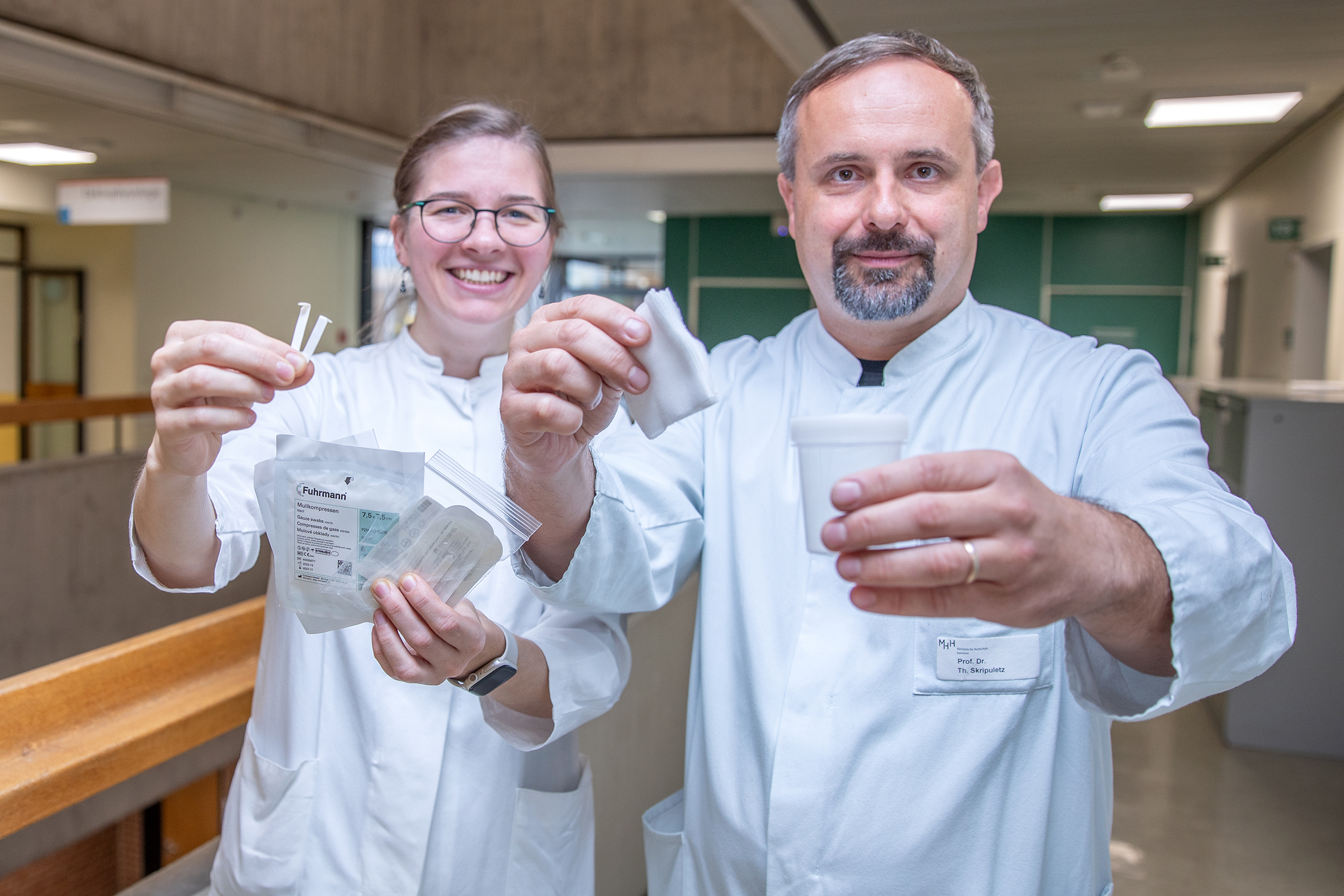MHH project investigates differences in neurological symptoms between multiple sclerosis and the rare Sjögren's syndrome

Dr Tabea Seeliger and Professor Dr Thomas Skripuletz are now looking for new ways to diagnose the autoimmune disease and differentiate it from the clinically similar inflammatory disease multiple sclerosis. Copyright: Karin Kaiser / MHH. Copyright: Karin Kaiser/MHH
![[Translate to Englisch:] Copyright: Karin Kaiser/MHH [Translate to Englisch:] Schirmer-Tests und Mullbinden für die Sjögren-Diagnose](/fileadmin/mhh/presse/MHH_Insight/2023/231199P_Unterschied_MS_Sjoegren_2.jpg)
Too little tear fluid or saliva can indicate Sjögren's disease. For Sjögren's diagnosis Schirmer tests and gauze bandages are used. Copyright: Karin Kaiser/MHH
Different diseases can cause similar symptoms. For treatment, however, it is important to know which cause is responsible for the symptoms. This is because a medication that helps against one disease may be ineffective or even harmful for another. This is precisely the problem that arises in the treatment of multiple sclerosis (MS) and Sjögren's syndrome. Both are autoimmune diseases caused by an overregulation of the immune system. MS primarily manifests itself in so-called demyelination foci, in which the protective outer layer around the nerves in the brain and spinal cord is destroyed. In Sjögren's syndrome, on the other hand, it is mainly the salivary and lacrimal glands that are attacked. However, as with MS, the inflammation can also attack the nerves in the brain and spinal cord, causing paralysis, fatigue, sensory disturbances or even visual impairment.
A research team led by Dr Tabea Seeliger, assistant physician at the Department of Neurology with Clinical Neurophysiology at Hannover Medical School (MHH), is now investigating how the clinically very similar clinical pictures can be differentiated from one another. The focus is on damage to the central nervous system. "We want to improve diagnostic differentiation and thus enable optimal treatment strategies for those affected," says the physician. She has been awarded the prestigious Oppenheim Prize for scientific research in the field of multiple sclerosis, endowed with 50,000 euros, for the project.
Largest cohort in Germany
For their investigations, the researchers want to create a study group of 288 patients with MS, Sjögren's or a combination of both diseases. Although Sjögren's syndrome is one of the rarer diseases, the MHH has the largest cohort of patients in Germany thanks to its extensive expertise and can therefore access a sufficiently large number of cases with neurological problems. "Polyneuropathies with paralysis and other neurological deficits are not as common in Sjögren's sufferers as inflammation of the salivary and lacrimal glands, but they do occur more frequently and are sometimes more severe than previously thought," explains Professor Dr Thomas Skripuletz.
Testing for Sjögren's is routine at the MHH's Department of Neurology, particularly in cases of severe polyneuropathies. Tear and saliva samples from those affected are analysed. If there is a suspicion, a physician from the Ear, Nose and Throat Clinic takes a biopsy of small salivary glands after a local anaesthetic, which are then analysed under a microscope. This allows Sjögren's syndrome to be proven or ruled out. "We have been researching this topic for years and now have more than 500 patients in our cohort, half of whom have neurological symptoms," emphasises the neuroimmunologist.
As part of the study, MRI images of the skull and spinal cord will initially be taken, focussing primarily on inflammatory changes. "We are looking at how many lesions there are, what exactly they look like and where they are located," explains project leader Dr Seeliger. The researchers are also looking for so-called autoantigens in the patients' blood serum and cerebrospinal fluid. These are the body's own structures, for example on cell surfaces, which are falsely recognised by the immune system as not being the body's own and are fought against. As potential biomarkers, they could facilitate a precise diagnosis. Precisely analysing the metabolism of patients could also provide information about the specific progression of MS and Sjögren's disease.
Improving treatment decisions
The researchers hope that the new findings could also improve treatment for those affected. Although there are drugs on the market for MS, the disease cannot be cured. And there are still no approved drugs for Sjögren's syndrome; treatment is always a case-by-case decision. "Once we know more, we will be able to predict more precisely which MS drugs could also help with Sjögren's and which are more likely to have a negative effect," explains Professor Skripuletz. Promising therapeutic approaches could also be the starting point for a clinical trial. "Sjögren's syndrome is probably underdiagnosed," says the neuroimmunologist. In Germany, around one in 500 people suffer from MS. The physician estimates that two per cent of these are also affected by Sjögren's syndrome.
The project is being carried out in co-operation with the MHH Clinic for Rheumatology and Immunology, the MHH Institute for Diagnostic and Interventional Neuroradiology and the Fraunhofer Institute for Toxicology and Experimental Medicine ITEM.
Text: Kirsten Pötzke